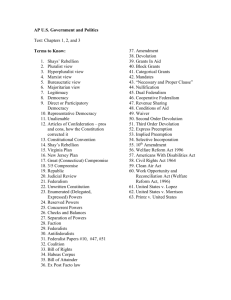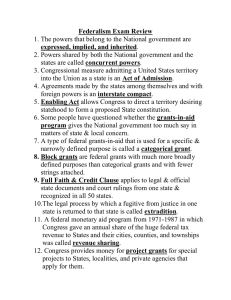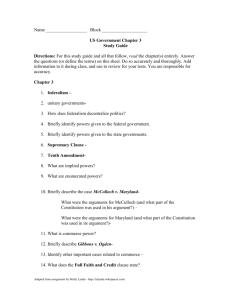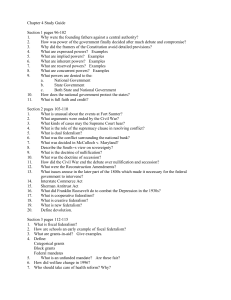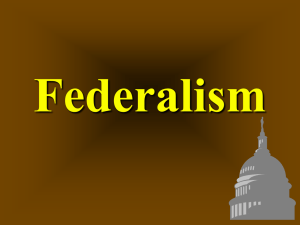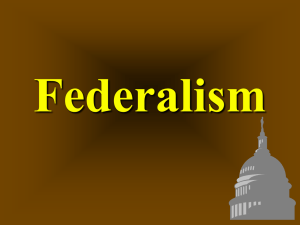Federalism
advertisement
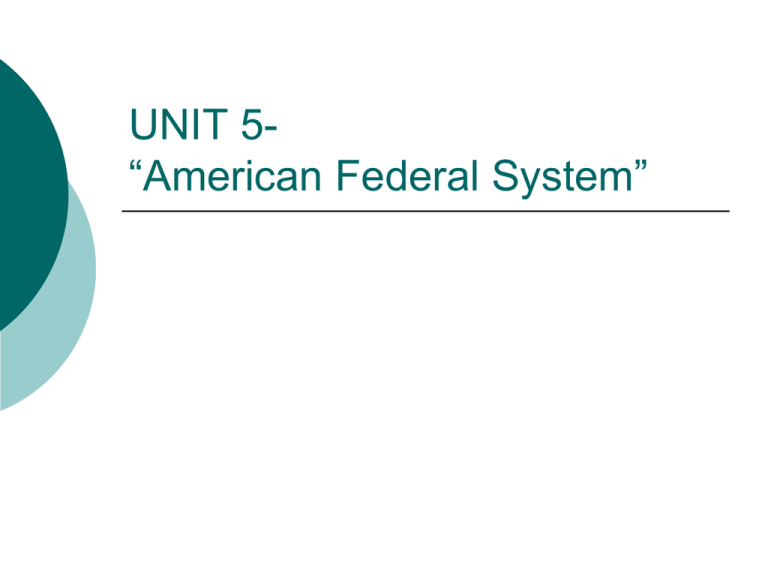
UNIT 5“American Federal System” Pre-Question #1 What is federalism? Federalism Federalism- The division of power between the National and State levels of government NATIONAL GOVERNMENT STATE/LOCAL GOVERNMENT In a Federal System: there are at least two levels of government that can make decisions independent of each other the levels of government have a protected right to exist Countries where Federalism exists: United States, Canada, Australia, India, Germany, and Switzerland In a Federal System: The state governments exist because of Constitution Federalism The single most cause of distention between states and national governmentIs the power battle between national government and state government Usual argument is whether the national government has the right to impose rule on the states or if the states should decide Federalism Since the 104th Congress it has been the national goal to shift responsibility back to states. Known as Devolution is the shift of responsibility back to the states State Run Programs Federal funds and regulations with state implementation occurs in these areas: STATE RUN PROGRAMS Welfare programs Interstate highway system Urban renewal programs Employment and unemployment agencies Water and air programs National guard The Founders A Federal republic with both national and state having separate and independent powers. Both equal in power. This had never been done before. So ….. The founders create a government that had never been done before that consisted of two separate and independent powers… Problem with the 10th amendment 10th amendment gives power to the states The Problem is that is not specific and detailed enough Pre-Question #2 What are implied powers and enumerated powers? 5b Implied Powers are not specifically granted by the Constitution Congress has the power to "make all laws necessary and proper for carrying into execution" Enumerated Powers are specifically mentioned and defined in the Constitution Nullification The idea that states can pick and choose what national laws they want to follow Powers Denied to the National Government May not violate the Bill of Rights May not impose export taxes among states May not use money from the Treasury without the passage and approval of an appropriations bill May not change state boundries Powers Denied to the State Government May not enter into treaties with other countries May not print money May not suspend a persons rights with due process Pre-Question #3 What is an initiative? What is a referendum? What is recall? State Sovereignty Initiative- voters demand through petition for an issue to be placed on the ballot and voted on by the general public. Referendum- the legislature places the issue before the public for them to decide Recall- voters remove an elected official by asking for a new election Grants in Aid Grant-in-aid is money given to states by national government that can be land grants or cash grants Land grants For college Canals and roads Flood control projects Cash grants- intergovernmental lobby Federal money State run programs Terms are set by the national government for the use of their fund called conditions of aid Categorical grants A Categorical Grant is federal aid given for a specific purposesinterstate highways, food stamps, medicaid Categorical grants use revenue sharing- both fed and state put up percentages of the cost of a project BLOCK MONEY A Block Grant is money from the National government to the states used for certain government functions (not specific like categorical grants) examples-: law enforcement, education Used by state discretion on specifics. What helps tell the Federal Government tell the States what to do? Federal money helps aid the national government into telling the state governments what to do. The Elastic Clause The Elastic cause states- the government can make all laws necessary and proper to carry out their given duties is known as the necessary and proper clause.


